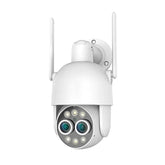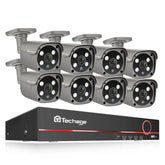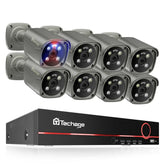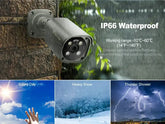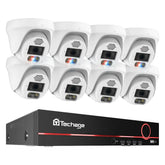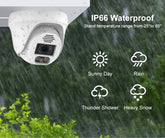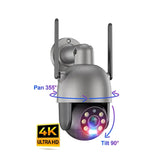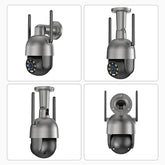IP Cameras for Traffic Management: Enhancing Road Safety and Efficiency
In an era of increasing urbanization and traffic congestion, effective traffic management has become a critical concern for cities worldwide. IP cameras, with their advanced features and capabilities, offer valuable tools for monitoring and managing traffic flow. In this article, we will explore the role of IP cameras in traffic management, focusing on how they contribute to improving road safety and efficiency. From real-time monitoring and incident detection to data analysis and intelligent control, IP cameras play a vital role in shaping the future of transportation.
Real-Time Traffic Monitoring:
IP cameras provide real-time traffic monitoring capabilities, allowing traffic authorities to gather valuable data on road conditions, congestion levels, and traffic flow. By strategically placing cameras at key intersections, highways, and critical points, traffic managers can monitor live video feeds, detect bottlenecks, and take proactive measures to alleviate congestion and ensure smooth traffic flow.
Traffic Data Collection and Analysis:
IP cameras provide a wealth of data that is valuable for traffic planning and analysis. By monitoring traffic volumes, speeds, and vehicle classifications, these cameras generate detailed data on traffic patterns and trends. This data can be analyzed to identify congestion hotspots, peak traffic hours, or areas in need of infrastructure improvements. By understanding traffic patterns, authorities can make informed decisions on road network design, capacity expansion, or transportation infrastructure investments.
Traffic Violation Monitoring:
IP cameras can be utilized to monitor and enforce traffic regulations, such as speed limits, red light violations, and illegal lane changes. With the integration of video analytics and automatic license plate recognition (ALPR) systems, authorities can identify and capture violators, allowing for effective enforcement and promoting adherence to traffic rules. This helps deter reckless driving behavior and enhances road safety for all road users.
Traffic Flow Optimization:
IP cameras assist in optimizing traffic flow by providing valuable data for traffic engineering and planning. Through video analytics, cameras can measure traffic volumes, vehicle speeds, and congestion levels. This data helps traffic engineers identify bottlenecks, evaluate road capacities, and implement appropriate measures to improve traffic flow. By making data-driven decisions, authorities can optimize traffic signal timings, implement lane management strategies, and deploy resources effectively, leading to enhanced road efficiency.
Intelligent Traffic Management Systems:
IP camera networks form the backbone of intelligent traffic management systems. These systems use advanced algorithms and data analytics to optimize traffic signal timings, dynamically adjust lane assignments, and manage traffic flow based on real-time conditions. By leveraging the power of IP cameras and intelligent algorithms, traffic management systems can reduce congestion, shorten travel times, and enhance overall transportation efficiency.
1). Adaptive Traffic Signal Control:
Traditional traffic signal control systems operate on fixed timings, regardless of actual traffic conditions. In contrast, intelligent traffic management systems utilize data from IP cameras to dynamically adjust signal timings in response to real-time traffic flow. By analyzing traffic patterns and densities, these systems optimize signal phasing and durations, allowing for smoother traffic progression and reduced congestion. Adaptive traffic signal control ensures that intersections operate efficiently, minimizing delays and improving the overall flow of vehicles.
2). Dynamic Lane Management:
IP cameras play a crucial role in implementing dynamic lane management strategies. By monitoring traffic volumes and detecting congestion or incidents, cameras can provide real-time information on lane occupancy and traffic distribution. Intelligent traffic management systems utilize this data to dynamically allocate lanes, open or close reversible lanes, or implement variable speed limits. These dynamic lane management strategies optimize the use of available road capacity, ease congestion, and improve traffic flow.
3). Traveler Information and Communication:
IP cameras can also be used to provide real-time traveler information and communication. By displaying live video feeds or traffic updates on dynamic message signs, drivers can be informed about current road conditions, incidents, or alternate routes. This improves situational awareness and allows drivers to make informed decisions, reducing congestion caused by unnecessary traffic or delays due to accidents. Furthermore, IP cameras can support communication systems that allow authorities to broadcast important messages or emergency alerts to drivers, enhancing overall safety on the road.
Intelligent Intersection Management:
IP cameras play a crucial role in managing intersections, which are often traffic hotspots and prone to congestion. By combining video analytics, sensor data, and intelligent algorithms, cameras can detect and track vehicles, pedestrians, and cyclists at intersections. This information enables intelligent intersection management systems to optimize signal timings, prioritize specific vehicle movements, and enhance safety by providing warnings or alerts to drivers. Intelligent intersection management improves traffic flow, reduces congestion, and minimizes the risk of accidents.
Enhanced Security and Law Enforcement:
IP cameras contribute to road safety by enhancing security and enabling effective law enforcement. Cameras placed along roadways can deter traffic violations, such as speeding, red light running, or illegal parking. Video analytics algorithms can automatically detect such violations and trigger alerts or capture evidence for enforcement purposes. By leveraging IP cameras, authorities can promote compliance with traffic laws, reduce accidents caused by reckless driving, and create a safer road environment.
Data Analysis and Planning:
The data collected by IP cameras can be analyzed to gain valuable insights for transportation planning and infrastructure development. By analyzing traffic patterns, peak hours, and congestion hotspots, authorities can identify areas in need of improvement and implement targeted solutions. This data-driven approach helps optimize road networks, plan for future infrastructure projects, and ensure efficient use of resources. IP cameras serve as valuable tools for data collection, allowing authorities to make informed decisions and create sustainable transportation systems.
Integration with Intelligent Transportation Systems:
IP cameras can be integrated with other Intelligent Transportation Systems (ITS) to create a comprehensive and interconnected traffic management ecosystem. By integrating IP cameras with technologies such as traffic signal control systems, dynamic message signs, or vehicle detection sensors, authorities can achieve a higher level of automation and coordination. This integration enables real-time data exchange, synchronized control strategies, and adaptive traffic management, leading to improved road safety, reduced congestion, and enhanced travel experiences.
IP cameras have revolutionized traffic management by providing real-time monitoring, incident detection, data analysis, and intelligent control capabilities. With their ability to enhance road safety, optimize traffic flow, and contribute to efficient transportation systems, IP cameras play a vital role in shaping the future of urban mobility. However, it is essential to ensure responsible use of these technologies, addressing privacy concerns and complying with relevant regulations. By harnessing the power of IP cameras in traffic management, cities can create safer, more efficient road networks that improve the quality of life for residents and visitors alike.


